Spanish Version
12-Step Daoyin Health Preservation Exercises
Health Preservation was developed in
ancient China to enhance physical and mental health based on the ancient
Chinese medical bible, Huangdi Nejing – The Yellow Emperor’s Cannon of Medicine. It originates from the theories of I Ching (The Book of Changes), and the Traditional Chinese Medicine (TCM).
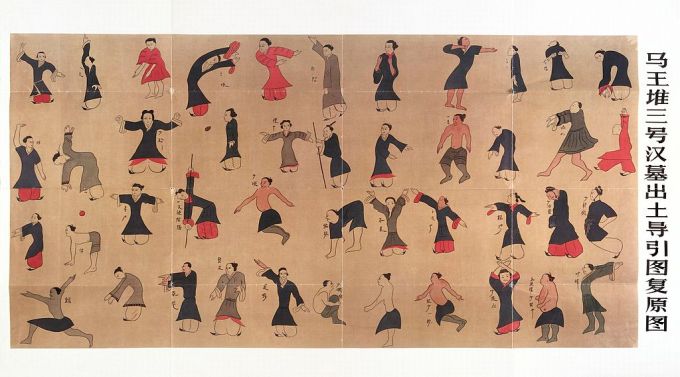
Daoyin Tu - chart for leading and guiding people in exercise for improving health and treatment of pain, containing animal postures such as bear walk. This is a reconstruction of a 'Guiding and Pulling Chart' excavated from the Mawangdui Tomb 3 (sealed in 168BC) in the former Kingdom of Changsha. The original is in the Hunan Provincial Museum, Changsha, China. Credit: Wellcome Library, London. Wellcome Images images@wellcome.ac.uk http://wellcomeimages.org
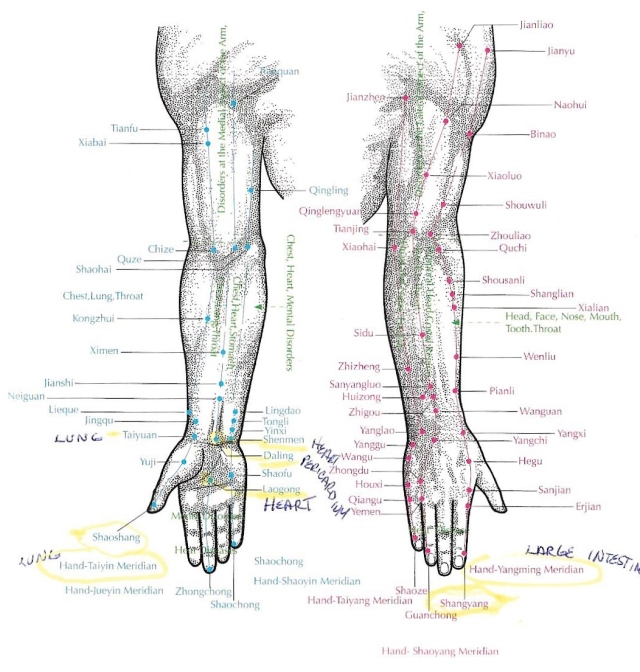
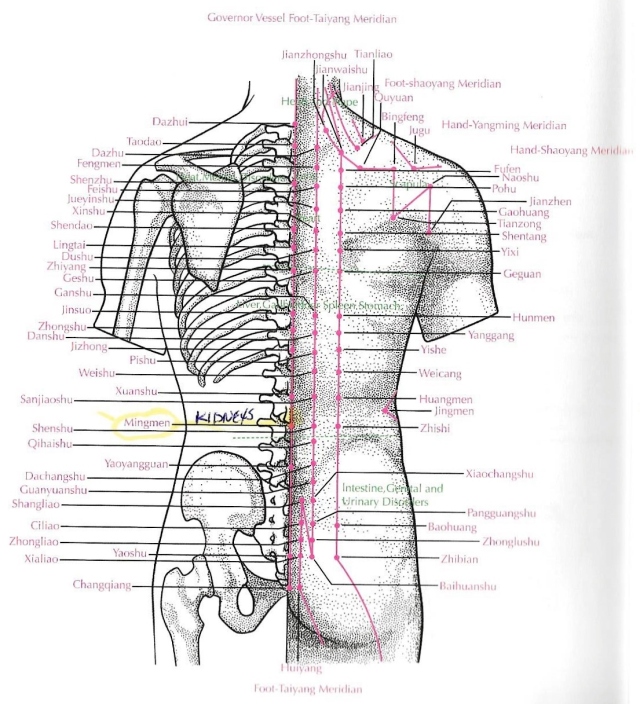
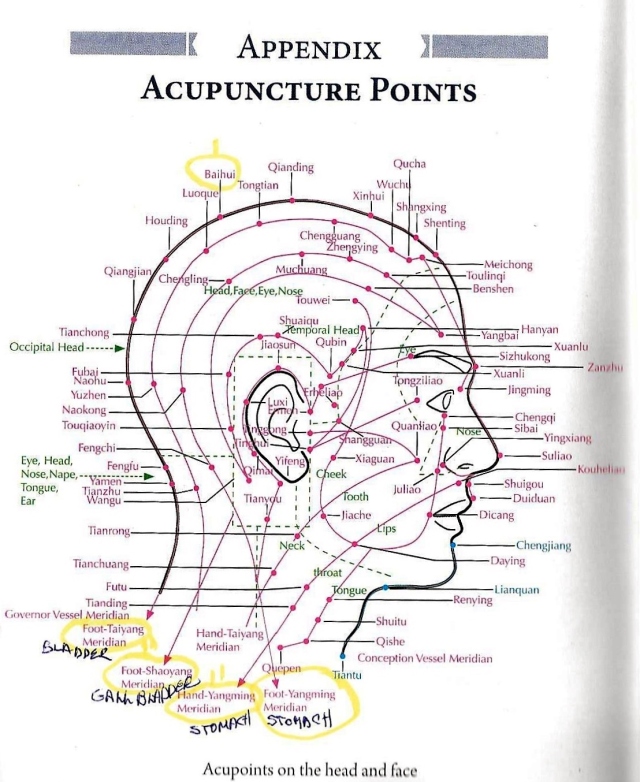
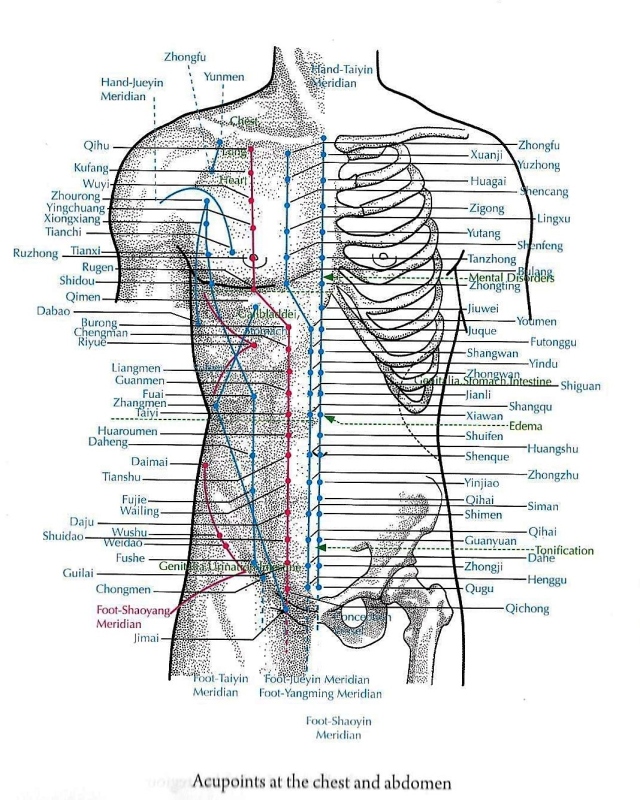
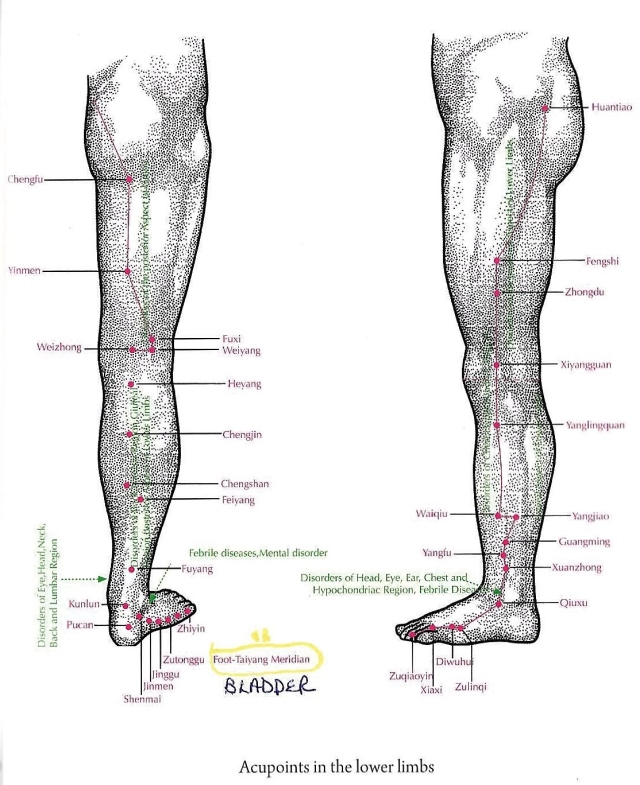
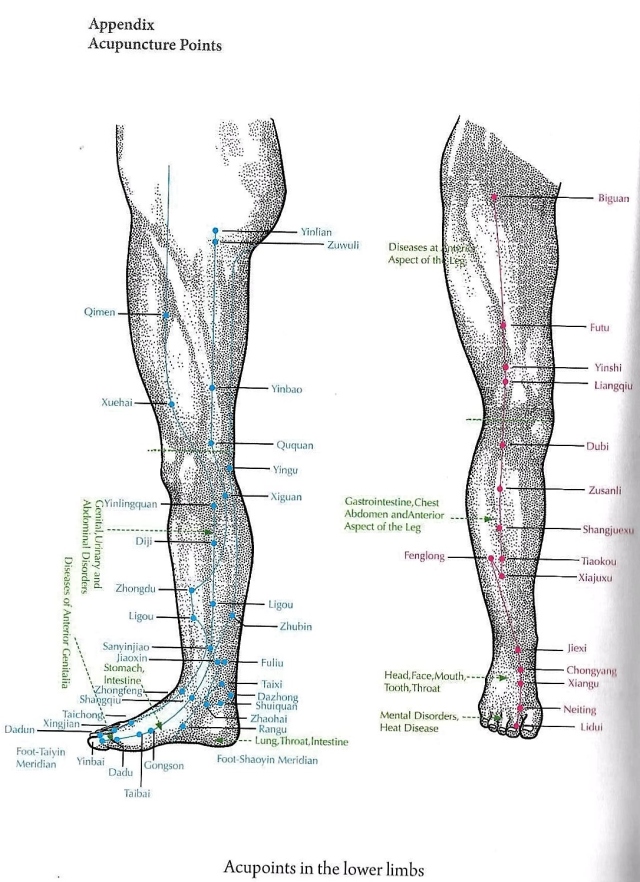
For the complete movements, CD, DVD, and acupuncture points and meridians, please refer to the book:
12 Step Daoyin Health Preservation Exercises – Dao Yin Yang Sheng Gong Shi Er Fa – The Chinese Health Qigong Association – Health Qigong – Foreign Languages Press
Designed and compiled by the Chinese
Health Qigong Association, it consists of 12 steps of exercises adapted
from over 50 routines of Daoyin Health QiGong developed since 1974 by
Zhang Guangde, a professor from the Beijing Sports University.
This new set of Qigong exercises combines Daoyin with healthcare, limb exercises, and mental and spiritual relaxation, the 12 steps flow harmoniously from one movement to the next.
This new set of Qigong exercises combines Daoyin with healthcare, limb exercises, and mental and spiritual relaxation, the 12 steps flow harmoniously from one movement to the next.
Based on the principles of Traditional Chinese Medicine, it concentrates on the Zang Fu
organs comprising the heart, liver, spleen, lung, kidney, gall bladder,
stomach, small and large intestine and bladder. It works the meridians,
balancing yin and yang, the Five Elements, Qi and blood. It can be
practiced in both seated and standing positions and the movements are
graceful and easy to learn and are suitable for all ages. The stands are
effective for promoting good health, cultivating the spirit and
prolonging life expectancy.
Daoyin – 206 BC – Meridian fitness
exercise combining limb movements and breathing. The concept is simple,
maintaining the spirit as well as the organs through illness prevention
prior to treatment, health fitness, inner vitality of the body,
temperance and harmony to prevent various organs from injury.
Treatments such as deafness prevention ‘yinlong,’ neck stretching ‘yinxiang’ and limb and breathing exercises, ‘yanghu’. Incorporating exercises imitating animal movements like bear climbing a tree ‘xionging,’ this set of forms suggests that for the sake of physical health and energy, we have to pay special attention to our seven emotions; happiness, anger, worry, yearning, sorrow, horror and surprise.
Treatments such as deafness prevention ‘yinlong,’ neck stretching ‘yinxiang’ and limb and breathing exercises, ‘yanghu’. Incorporating exercises imitating animal movements like bear climbing a tree ‘xionging,’ this set of forms suggests that for the sake of physical health and energy, we have to pay special attention to our seven emotions; happiness, anger, worry, yearning, sorrow, horror and surprise.
- Effect on life produced by movement; “Running water is never stale, the door hinge will never get worm-eaten.”
- Nourishing the spirit through regulating the mind; “Practicing Qi through regulating the breath.” “Circulating meridians through regulating the form.”
- Regular physical activities of wrist and ankle joints are auto massage of the 12 acu-points, improving Qi and blood flow.
Mind – regarded as water and fire, “can float, but also sink. Can warm, but also burn.”
Qi – the mother of all life, “movement and breath should follow each other.” Deep, long abdominal breathing with gentle movements.
Form – corporeal body as well as meridians. Blockage of Qi may bring unease of spirit and sickness. “Qi always follows the mind.”
Qi – the mother of all life, “movement and breath should follow each other.” Deep, long abdominal breathing with gentle movements.
Form – corporeal body as well as meridians. Blockage of Qi may bring unease of spirit and sickness. “Qi always follows the mind.”
“Where your mind goes, the Qi flows.”
The movements standing and seating positions are:
Initial stance,
- Beginning of Heavens Creation (Qian Yuan Qi Yun)
- Double Fish Hung on the Wall (Shuang Yu Xuan Ge)
- Old Horse is Stabled (Lao Ji Fu Li)
- Ji Chang Shoots a Louse (Ji Chang Guan Shi)
- Bending the Body to Brush the Shoes (Gong Shen Dan Xue)
- Rhinoceros Gazes at the Moon (Xi Niu Wang Yue)
- Lotus Flower Appears Above the Water (fu Rong Chu Shui)
- Golden Rooster Heralds the Dawn (Jin Ji Bao Xiao)
- Wild Geese Land on the Beach (Ping Sha Luo Yan)
- White Cran Flies High in the Clouds (Yun Duan Bai He)
- Phoenix Salutes the People (Feng Huang Lai Yi)
- Qi and Breath Return to the Origin (Qi Xi Gui Yuan)
Ending Stance
Points of Attention
Standing Stance – Tip of the tongue touching the palate, clench teeth.
-
Concentrate on the Dantian, dispel all thoughts, breath slowly. “Let the body fly like a swallow in the sky.”
1. – Beginning of Heaven’s Creation
- Exert slight force to the thumbs to increase the range of rotation of the arms.
- The degree of the squatting action differs from person to person.
- Make the sound “hu” silently (Spleen).
- Helps the hand Taiyin lung meridian and the Yangming large intestine hand meridian.
- Respiratory system, colds, bronchitis.
2. – Double Fish Hung on the Wall – Refers
to two fish with the head and tail connected representing Yin and Yang.
Implies the growth and decline of them and the transformation between
them in nature.
- Palm onto the wrist, phalanx of the ring finger placed on the Taiyuan acupoint as if feeling the pulse. When feeling the pulse, place the ring, middle and index finger at the end of the palm.
- Concentrate on the Taiyuan LU 9 Acu-point (Great Abyss).
LU9 Taiyuan- On transverse crease of the wrist on the lateral side ofthe radial artery.
-
After twisting the finger on the Taiyuan, put the palm of the opposite hand in front of the chest, palm to palm and Laogong to Laogong acupoint. Rub palms.
P8 Laogong – On the transverse crease of the palm just below where the tip of the middle finger rest when a fist is made. Between the 2nd and 3rd metacarpal bones. - Make the sound ‘Hu‘ silently.
3.- Old Horse Is Stabled – Quote
from a military strategist during the Three Kingdoms named Cao Cao: “An
old steed in the stable still aspires to gallop a thousand li, an old
man of high endeavor cherishes great ambition.” People of endeavor still
have ambitions although they are old.
- Hook wrists gradually – Shaoshang LU 11 and Shangyang Ll 1 acupoints connected.
Shaoshang LU 11 – On the extensor of the thumb, at the junction of lines drawn along the radial border of the nail and the base of the nail, approximately 0.1 cun from the corner of the nail.Shangyang Ll 1 – Posterior to the corner of the nail on the radial side of the index finger.
- When clenching the fists with bent elbows in front of the chest, use the middle fingertip to touch Laogong acupoint. Wrists must be bent fully for the hooked hands.
- Make the sound “si” silently (invigorates the lung).
- Concentrate the mind on Taiyuan acupoint.
Pressing Laogong helps improve function
of the heart and blood pressure. Hooking hands and wrists and doubling
the fingers help to invigorate the heart and lungs ans they have the
effect of massaging Taiyuan (lung meridian), Daling, the source of the pericardium meridian acupoint and Shenmen,
the source of the heart meridian acupoint. Helps to supplement the
spleen Qi and increases the body’s resistance improving the health.
4.- Ji Chang Shoots a Louse – Title
of a story relating how Chang apprentices to the expert archer Fei Wei
in ancient times. “If you want to learn to shoot arrows well, you must
see a very small object as a very large one, and see a vage object very
clearly.” Ji Chang caught a louse and tied it to the tail hair of an
ox. Three years later, the louse looked as big as a cart wheel. He made a
bow and shot an arrow straight through the louse, leaving the ox tail
hair intact.
- When turning the body clench the fists tightly, fingers touching Laogong acupoint (center of the palm).
- Pulling the bow and shooting the arrow helps relax the chest and promotes normal flow of Qi, regulating heart and lungs.
- Concentrating the mind on Mingmen acupoint (back Kidneys’ area) and pressing heels to the ground sideways to twist Yongquan acupoint helps nourish and strengthen the kidneys and waist.
5.- Bending the Body to Brush the Shoes
– removing dust and harmful matter from the surface of the body,
dispelling distracting thoughts to purify the brain and relieve mental
strain.
- While breathing out, bend with legs straight. With the palm rub the leg downward, opposite arm rotate outward. Phalanxes along the foot Taiyang bladder meridian, Palm along the foot Shaoyang gall bladder meridian. Palm along foot Yangming stomach meridian reaching the outer ankle. Head raised slightly.
- When body rises, breathing out, relax and straighten upper body. bent fingers facing up Zhongchong acupoint at the tip of the middle finger touching Laogong at the center of the palm.
- Concentrate on Mingmen acupoint. (Kidneys)
- Relax the body.
- Straighten legs when bending forward. Du meridian runs through the spinal column and connects with the kidneys. Waist is the essence of the kidneys. Du, Chong and Dai meridians are located in the waist and the movement helps to nourish the kidneys.
- People with high blood pressure should raise the head when practicing this step.
6.- Rhinoceros Gazes at the Moon
– Chinese tradition holds that the horn of the rhinoceros has white,
thread-like lines which connect the tip of the horn to the brain. The
movement turning of the body to improve loins and kidneys in particular.
- Concentrate on Mingmen acupoint. (Kidneys)
- Turn the waist with a big range of movement.
- When clenching the fists, Zhongchong acupoint should touch Laogong acupoint for an instant.
- Relaxes the neck, back and waist. Relieves pain in shoulders, elbows, wrists, neck, back and waist.
- Helps strengthen heart and functions of the lungs. Clear and regulate Sanjiao meridian.
7.- Lotus Flower appears Above the Water – The Lotus flower likes the water but it is not contaminated by mud.
- Silent sound “si“.
- Concentrate the mind on Taiyuan acupoint.
- Helps regulate the Sanjiao meridian, improves the functions of all internal organs.
8.- Golden Rooster Heralds the Dawn – stand on one leg and extends the other backwards, as if a rooster is crowing at dawn.
- Concentrate the mind on Dantian.
- Pulling the heels up to press Yongquan acupoint helps to incite the kidney meridian of foot – Shaoyin to nourish Yin and the kidneys.
- Sound “chui” nourishes Yin and kidneys.
9.- Wild Geese Land on the Beach
– is a musical piece for the qin traditional Chinese seven stringed
instrument. It describes the flying, landing and crying of wild geese on
a beach.
- Concentrate the mind on Laogong acupoint. (helps regulate the hand Jueyin pericardium meridian, relieve heart and regulate the flow of blood).
- If not able to do the cross legged sitting stance, change it to the resting stance. Bending the legs helps to remove obstruction from the meridians of the three yin and three yang of the foot. Improves the functions of spleen, stomach, liver, gall bladder and kidneys.
- Sound “he” helps relieve the heart.
10.- White Crane Flies High in the Clouds – regarded as able and virtuous of moral integrity.
- Move Hegu acupoints on the palms as the arms are rotated inward to rub the sides of the body upward to near Dabao acupoint (lateral side of chest).
- Rotate palms with Hegu acupoints while the arms are rotated outward.
11.- Phoenix Salutes the People
– The Phoenix, a legendary auspicious king of the birds, was one of the
four spirits of ancient Chinese Mythology. Unicorn, Turtle and dragon
were the others.
- Sound “hu” soothes and relieves the stomach and spleen.
- Concentrate the mind on Dantien.
- Turning the body and rotating the arms help to remove obstruction from Ren and Du meridians and the 3 Yin meridians and 3 Yang meridians of the hand.
- Bending the wrists to form hooked hands stimulates the well points and source acupoints of the 3 Yin and 3 Yang meridians of the foot. Helping improve the heart, lungs, large intestine and small intestine.
- Turning up the toes stimulates the source acupoints of the Yin meridians and 3 Yang meridians of the foot. Helps to improve the liver, gall bladder, spleen, stomach, bladder and kidneys.
12.- Qi and Breath Return to the Origin
– For the purpose of preserving health, we should also pay attention to
receiving Yin Qi from the earth and absorbing Yang Qi from the sun and
heaven. Accept equal amounts of Yin Qi and Yang Qi depending on his or
her specific conditions.
- Concentrate the mind of the collection of Qi from Guanyuan acupoint. Guanyuan is located on the Ren meridian and is one of the acupoints of Dantian. Meeting point for the three Yin meridians of the foot and the Ren meridian, and one of the front Mu points of the small intestine meridian; it is a major acupoint of long life. Invigorates the central Qi, nourish the origin Qi, internal organs and regulates Yin and Yang.
- Concentrate the mind on the saliva. Swallow with a clear sound.
- Huangfu Long (220-280), said: “People should drink jade water every morning to be strong and in good health.” Jade water is the saliva. After rinsing the mouth in the morning, the mouth is full of saliva. Swallow it. This is called refining the essence.” (From Prescriptions Worth a Thousand Pieces of Gold for Emergencies).

Daoyin Tu - chart for leading and guiding people in exercise for improving health and treatment of pain, containing animal postures such as bear walk. This is a reconstruction of a 'Guiding and Pulling Chart' excavated from the Mawangdui Tomb 3 (sealed in 168BC) in the former Kingdom of Changsha. The original is in the Hunan Provincial Museum, Changsha, China. Credit: Wellcome Library, London. Wellcome Images images@wellcome.ac.uk http://wellcomeimages.org
Daoyin 導引 (a.k.a. Tao Yin),
means “guiding and stretching,” is a traditional Chinese form of
“calisthenics” (Grk.: “beautiful strength”; physical exercise) or
“gymnastics” (Grk.: “to train”). Traditionally and historically
speaking, Daoyin practices are stretching exercises, usually combined
with breath-work. Some Daoyin practices involve specific breathing (huxi 呼
吸) patterns. The earliest forms of Daoyin were developed during the
Early Han dynasty (206 BCE-8 CE), in the context of health and longevity
as well as therapeutic movements. Daoyin practice is also sometimes
referred to as Yangsheng 養生, which literally means “nourishing life.”
Some of the earliest sources on Daoyin include the Daoyin tu 導引圖 (Exercise Chart) and Yinshu 引書 (Stretching Book).
Dating to around 168 BCE, the Daoyin tu
was discovered in the burial materials of Mawangdui 馬王堆 (near Changsha;
Hunan). It consists of forty-four color illustrations of human figures
performing therapeutic exercises, with accompanying captions. The
exercises involve standing in specific postures that aim to cure
corresponding illnesses. Here it should be noted that the title of this
series of illustrations was supplied by modern scholars. The Yinshu,
which dates to around 186 BCE, is an archaeological manuscript
discovered at Zhangjiashan 張家山 (Jiangling, Hubei). Lacking
illustrations, it consists entirely of text. The second section
describes about a hundred Daoyin exercises.






For the complete movements, CD, DVD, and acupuncture points and meridians, please refer to the book:
12 Step Daoyin Health Preservation Exercises – Dao Yin Yang Sheng Gong Shi Er Fa – The Chinese Health Qigong Association – Health Qigong – Foreign Languages Press
No comments:
Post a Comment